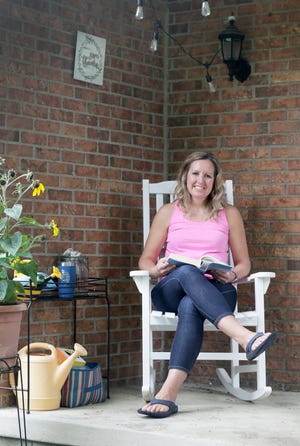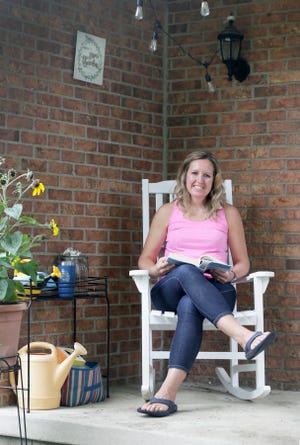
She looped the mask’s strings around her ears and, with her heart pounding so fast it seemed it would burst right out of her chest, she walked through the aisles of the garden center determined to pick out some spring flowers.
Baby steps, these were.
A few days later in May, Mackenzie White ventured into the pharmacy at Target to pick up a prescription for her husband. It was such an accomplishment for the 41-year-old photographer, writer and substitute teacher from Hilliard that her 13-year-old son made her a badge that shouted to the world: “I went to Target!”
Then not long ago, White met friends on a restaurant patio for a birthday celebration and, just last week, she stood in line at an Ohio Bureau of Motor Vehicles office and she didn’t panic even once.
Baby steps, indeed.
Having long lived with diagnosed anxiety and obsessive compulsive disorder — the kind where she has a real fear of germs and disease and uncleanliness — White had spent the 14 months of the COVID-19 lockdown either cocooned in her home with her family or running, walking or kayaking in wide-open spaces that were free of people and potential risk.
She had made great strides with her OCD before the pandemic, but suddenly, experts were telling her to worry about the very things she had worked so hard to overcome. So she was hopeful for the day when normality would return. Yet she soon discovered that emerging from lockdown wouldn’t be as easy as expected.
“I really haven’t felt a lot like me during the pandemic because I wasn’t able to do things that made me me,” she said. “My therapist told me recently, ‘I want you to do one thing every day that makes you feel like you.’ That really helped me … The more I do and I build on that, it gets easier.”

How to perform a mental-health check: “Am I OK?”
Coping with pandemic stress: “I have had to tap into my positivity for the sake of everything.”
American Psychological Association, OhioHealth experts say emerging from lockdown not easy
Lynn Bufka, of the American Psychological Association, told USA Today for a story that checking yourself can be a valuable tool.
“One of the biggest indicators is whether the person is really having trouble doing their day-to-day life,” Bufka told USA Today. “Are you able to fulfill your role as a mom, a teacher, a spouse, a daughter?”
If you’re struggling in areas that you previously weren’t, she said, things might be off track.
In a report issued in April, the APA reported grim findings that didn’t bode well for people to emerge from lockdown physically and emotionally healthy. Take, for instance, that 61% of respondents reported undesired weight changes since the start of the pandemic and two of every three said they were sleeping either more or less since the pandemic hit.
Dr. Richard Akins, program director for Outpatient Behavioral Health Services at OhioHealth, said the end of Ohio’s COVID-19 health orders earlier this month didn’t change feelings for everyone.
“The lockdown was, I guess, a trauma for a lot of people,” he said “They were isolated for a long period of time. And now, I think the same issues that were related to the lockdown seem to be prevalent now.”
Specifically, Akins has seen a spike in depression and anxiety. He said these spikes were mostly centered around the isolation and financial hardships brought on by the pandemic but that safety concerns about re-entering public life clearly now are a factor.
Coping with post-pandemic life: Here are some tips
Why are we still so anxious? Being together again is strange
With most pandemic health orders lifted, Akins encouraged people to continue with hobbies they picked up during the pandemic as a simple way to combat any new onset anxiety and depression.
For Akins, taking care of yourself includes both eating and exercising regularly, but it’s also about being willing to talk to others and ask for help when needed.
“Don’t just be isolated to yourself and continue the isolation that you’ve experienced,” he said. “Begin to experience those things that you enjoy again.”
Mother in North Linden trying to deal with new fears from relaxation of COVID-19 rules

So much of what the pandemic and lockdown brought exacerbated feelings for those already dealing with mental health issues. Isolation isn’t good for depression and fear of the unknown, and a change in habit often feeds already existing anxiety.
But the re-opening can breed more fears for many.
Just ask Maggie Baxter. She has long dealt with anxiety and a touch of agoraphobia and claustrophobia.
An introvert by nature, when the pandemic hit she tried to just see the good. She and her husband already homeschooled their children and she loves domesticity — cooking meals, doing chores — so she looked forward to the time sheltered with family while she worked from home as a freelance writer.
But about six months in, isolation and fear of the pandemic, coupled with social unrest, what she saw as the rise of white supremacy in society, and her general loss of faith in humanity to do the right thing, nearly sunk her.
She couldn’t eat. She couldn’t sleep. She was afraid to be alone. Her husband convinced her to go back on medication.

She did, and things got better.
Then the world opened up again. Now Baxter worries about different things having two children too young to receive the vaccine and a foster child to care for and protect.
“Public spaces before, because of the health orders in place, I felt like they were very well-controlled environments. Everybody had to follow the same rules, and so I felt like taking the kids to the doctor, going to the grocery store, running quicks errands … felt OK,” the 42-year-old from the North Linden neighborhood said.
But now?
“Now I have to trust people based on an honor system,” she said, referring to a different set of (unmandated) guidance for vaccinated and unvaccinated people. “I don’t trust society to look out for my family.”
Our homes, she said, feel safe again — having vaccinated friends over, gathering with others on a patio or in the yard or even inside. But public spaces like stores, banks and restaurants seem just as risky now as during the pandemic.
“I am hoping that some of my anxiety right now is irrational,” Baxter said. “Is the risk less than that what my anxiety is telling me right now? I hope so. I have to keep that in mind.”

She and her therapist talk about “exposure therapy,” which means confronting your fears. Being isolated the past 14 months meant that Baxter was able to easily avoid the public spaces she needed to grow comfortable in.
With the reopening, she said, “I realize I am out of practice and in danger of a setback. Will my social anxiety keep me at home? Will panic attacks start happening with greater frequency?”
She is working through it. Just like White. With baby steps.
But she wants others who have the same feelings to know they are not alone: “I’m trying my best to be gentle with myself and with others.”
For more mental health resources visit mhanational.org/covid19, www.namifranklincounty.org or call the helpline at 1-614-501-NAMI(6264).
hzachariah@dispatch.com
@hollyzachariah
tcarlin@dispatch.com
@timcarlin_

